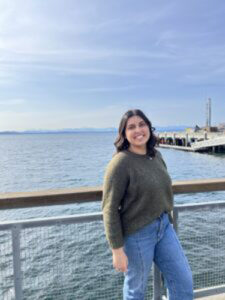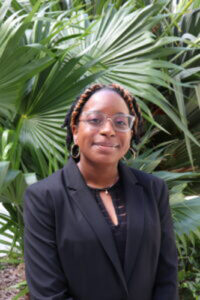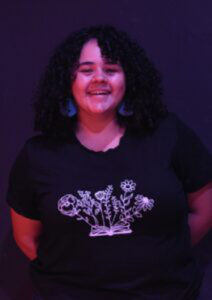2022 REU Participants

Lauren Chandarana
Biological and Agricultural Engineering Major at North Carolina State University
Class of 2024
http://www.linkedin.com/in/lauren-chandarana-2757a4205
Lauren is a senior studying Biological and Agricultural Engineering with an Ecological Concentration. Her passions and focus within her major include sustainability, green stormwater infrastructure, treatment wetlands, and stream restoration projects. Working with STEPS as an Undergraduate Researcher has been her only venture into a research project during her undergraduate experience. Her project, Analyzing Phosphorus Uptake in 3D-Bioprinted Arabidopsis thaliana Cells, allowed her to gain valuable lab and research skills. She will be entering the engineering industry after graduation but is planning to return to school later on to complete a Master’s Thesis Program in Engineering.
“Participating in this REU for the summer was a great experience! I loved being able to live in close proximity to the other REU students, we became great friends over the summer, and we would often share meals, host game nights, and explore the Raleigh-Durham area on the weekends. The research aspect was challenging, but it allowed me to use skills I learned in my engineering classes to think critically to address and solve the problems I faced during my research. Despite completing research outside my field of interest, I am thankful for this experience as it allowed me to further understand the process of research and get involved in a vast, collaborative research center. I felt supported by the STEPS administration throughout the summer; everyone was approachable and ready to help in any way they could, creating an environment where we could speak freely about our research experiences and get help addressing any issues we encountered.”
Research Poster: Analyzing 3D Bioprinted Arabidopsis thaliana to measure Pi Uptake
Project Description
During my summer at STEPS, I worked on the beginning phases of a research project with Jasmine, another STEPS REU student, under Dr. Ross Sozzani in the Plant Biology Department. We were assigned to work with a 3D bioprinter to measure the phosphorus uptake in plant cells from Arabidopsis thaliana, which is a variety of mustard seed that is heavily researched and fast-growing, making it an ideal specimen for research projects. In order to complete this project, we had to develop new procedures, modify existing ones, and learn how to use the lab equipment. The application of this project once completed will allow us to discover mutations in genes of plants that will uptake more phosphate from the soil and therefore be able to grow in lower phosphate concentrations and decrease the demand for phosphate-based fertilizers as a result.
Our first task was mixing growing media that did not contain phosphorus so we knew exactly how much phosphorus the plants were receiving and where it was coming from. Then, we had to prepare the seeds to be pipetted onto the plates with the media using water and a cleaning solution. After the seeds were pipetted, the plates were placed in the growing chambers so the seeds would sprout and begin to grow roots and leaves. After the allotted growing period of 5 days, we would cut the roots off the plants and extract the root cells. Then, we would mix the root cells with the bioprinting media containing varied levels of phosphorus concentrations and print them into droplets on a slide. By bioprinting the cells, we were able to isolate and track individual cells, which allowed us to quantify cell viability under each condition. Using the confocal microscope, we could analyze how the cells responded to phosphate concentrations in increments (0, 50, and 100%) of the standard phosphate concentration found in the growth media.
Due to time and supply constraints, we had to modify our project to analyze the plants’ responses to varied phosphate concentrations and could not quantify the intracellular phosphate uptake. We also started researching and gathering different gene mutations of these Arabidopsis plants that may allow for increased phosphate uptake by the plants.
Overall, our project produced the expected results with the 100% concentrations creating a more ideal growth environment than the 0% and 50% concentrations. We also found many future directions for the project, including developing methods to quantify the phosphate uptake by the plant cells and testing phosphate uptake in the plants with gene mutations.

Julianne Buggs
PhD Biological Sciences at Florida International University, First-Year
Microbiology and Immunology Major at the University of Miami, Class of 2023
http://www.linkedin.com/in/julianne-a-buggs-539941236
I am a microbiologist interested in plant-microbe symbiosis and pathogenesis. I have always enjoyed working with plants, and I believe that they can be ideal models for solving problems related to agriculture, climate change, and public health. During my time at STEPS, I collaborated with Dr. Doug Call and Dr. Jessica Deaver to analyze phosphorus-accumulating bacteria in a local wastewater system. Since then, I have worked at Oak Ridge National Laboratory modeling soil carbon storage in Populus trees. My experience at STEPS helped me gain confidence to apply for graduate school and continue to pursue a career in research. In the future, I hope to become a staff scientist at a national laboratory.
“The STEPS REU program was critical for my development as a scientist.”
Research Poster: Phosphorus Uptake and Release by Phosphorus Accumulating Organisms (PAOs)
Project Description
Phosphorus accumulating organisms (PAOs) store inorganic phosphate as polyphosphate granules, and accumulate volatile fatty acids (VFAs) to store as polyhydroxyalkanoates (PHAs). They are present in wastewater streams and used in biological nutrient removal processes at water reclamation facilities. Phosphorus removal by PAOs involves anoxic, anaerobic, and aerobic phases, coordinated with phosphorus uptake and release. In some wastewater facilities, phosphorus removal can become unstable, and reasons for these instabilities remain unclear. Toward addressing these knowledge gaps, our work focuses on two key aspects: (1) the role of the metal aluminum (which is often added as alum in wastewater facilities), and (2) microbial community composition differences between a stable and unstable full-scale phosphorus removal system, using chemical and biological techniques to understand phosphorus uptake and release. Chemical techniques involve the addition of alum to wastewater streams and analyzing PAO uptake of phosphorus through electron microscopy-based imaging and measuring soluble orto-phosphate concentrations. Biological techniques include completing DNA extraction and Nanopore sequencing to determine the bacterial and archaeal species present in the wastewater streams. Chemically, we expect that effective phosphorus removal will be shown in waste streams that are treated with alum to allow for polyphosphate storage by PAOs. Biologically, we expect effective phosphorus uptake will occur in microbial communities that have a symbiotic relationship instead of a competitive one. Applications of this research include environmental health; wastewater treatment and phosphorus removal are critical for preventing eutrophication and degrading water quality.

Stacy Santiago Garay
Industrial Biotechnology Major at the University of Puerto Rico-Mayaguez Campus
Class of 2024
https://www.linkedin.com/in/stacy-santiago-236203230/
I am currently studying Industrial Biotechnology, but my focus has always been towards Agricultural Biotech. The REU Summer Program at STEPS was my first internship, and it was a great learning experience. I got the opportunity to work with a mentor who introduced me to various topics and study fields regarding phosphorus and its impact on the environment. This experience sparked my interest in knowing more about the other major components in the soil and how they affect not only crops but water quality as well. I enjoyed my time in this REU Program and learned a lot about research and what that process looks like in the real world.
“A great first learning experience.”
Research Poster: Electrochemical Sensor for Detecting Phosphates
Project Description
My project focused on designing and making a lanthanum laser-infused sensor to detect high and low concentrations of phosphorus on different surface waters.

Pippin Bucholtz
Master’s Student in Agriculture and Environmental Sciences, North Carolina A&T
Sustainable Food Systems and Environmental Studies at Guilford College, Class of 2023
Pippin Bucholtz attended Guilford College in Greensboro, North Carolina where he earned bachelor’s degrees in sustainable food systems and environmental studies. After completing his master’s in agriculture and environmental sciences, he would like to pursue careers in soil science and permaculture design. Pippin was also recently named a Woodland Ellroy Hall Fellow, a prestigious award providing full tuition and a stipend to graduate students at A&T.
Research Paper: Solar Distillation of Urine to Produce Fertilizer and Water
